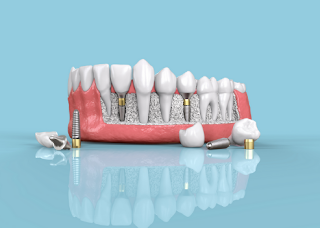Immediate implantation is a technique where the dental implants are placed and restored with a crown within 24-48 hours of tooth extraction. The immediate implants can increase patient satisfaction and treatment acceptance. People usually prefer immediate implants for better self-esteem and aesthetic preservation. Traditional implants will take more time. Hence the demand for immediate implants has seen a rise.
Benefits of immediate implants
There are a few advantages of getting an immediate implant, such as:
- Less time for treatment
- Patients acceptability
- Better self-esteem
- Natural-looking
- Can be placed in the same position of the extracted teeth
- Minimizes the need for angled abutments
- Works likes a regular teeth
- Less time for healing
- Prevents bone loss
- Helps to preserve the morphology of the peri-implant of the soft tissues
Candidates for immediate implants
Immediate Implants can be performed for the following conditions:
- Teeth missing in front or back
- Decayed teeth that cannot be rectified with any other treatments
- Missing teeth due to prior removal
- Difficulty in chewing due to other dental issues
- Uncomfortable dentures
- Gaps in the front teeth
- Infected gums which could lead to loss of that tooth
- For a better smile
- For a better dental appearance
- Eliminates further surgeries
Procedure
For a long term success rate in immediate implants, the doctors would require an appropriate diagnosis and treatment plan. There could be specific indications to obtain immediate implants, such as to attain primary stability with the right implant in an ideal therapeutic manner. Soft tissue, the quality, and quantity of the bone, the presence of pathology, and the condition of the adjacent teeth need to be taken into consideration while planning for an immediate implant.
Immediate implants will keep certain aspects during the procedure so that unnecessary mistakes can be avoided. The elements would include the presence of a buccal plate, primary stability, implant design, filling the gap between the buccal plate and the implant and the tissue biotype.
The doctor would initially rinse the patient’s mouth with a solution, and local anesthesia will be administered. When a particular area is numb, the damaged tooth will be extracted. The damaged or broken teeth would be carefully removed from the socket so that the other area around the bone would not get damaged. The implant is placed for primary stability to the root of the tooth. With the help of an abutment, the dentist will place a crown, which becomes the new tooth.
Immediate implants are considered to be a viable and predictable solution for missing teeth. This minimally invasive surgical technique helps to preserve the gingival aesthetics, which is a boon to the patient in the long run.
Blog reviewed By: Dr. Sudhakara Reddy
Mail us: drsudhakarareddy@gmail.com
Book appointment: implantdentistindia.com/book-appointment.html


No comments:
Post a Comment